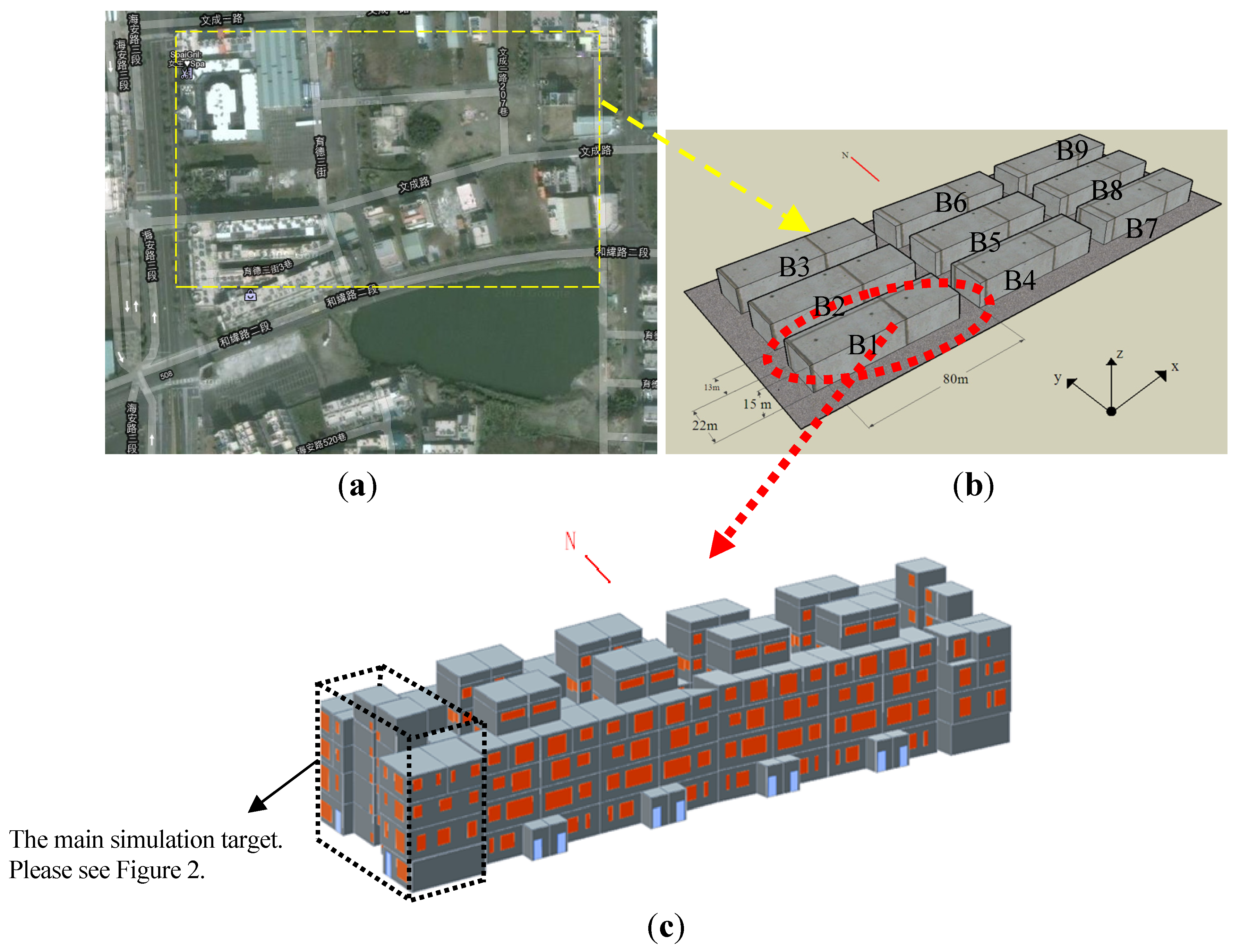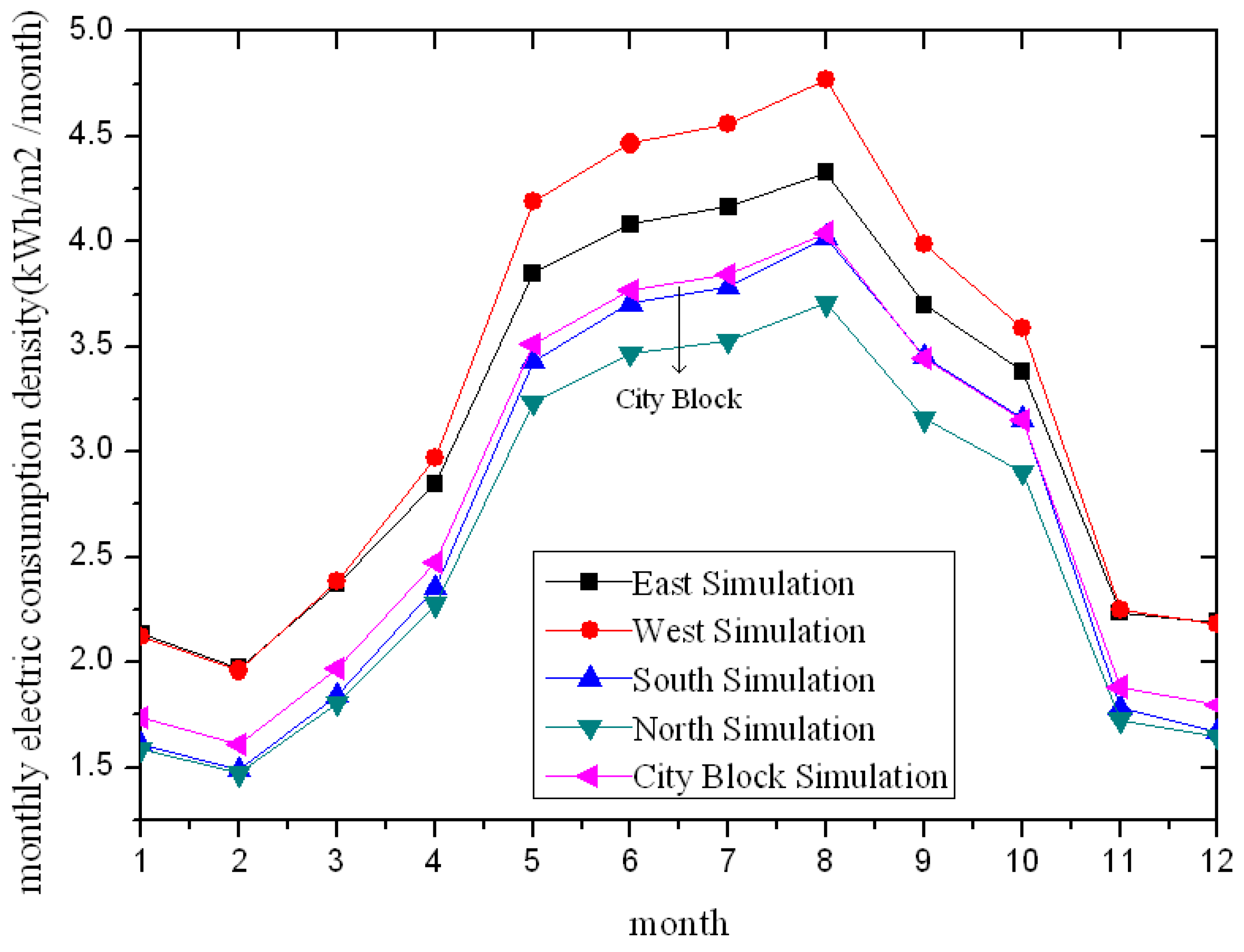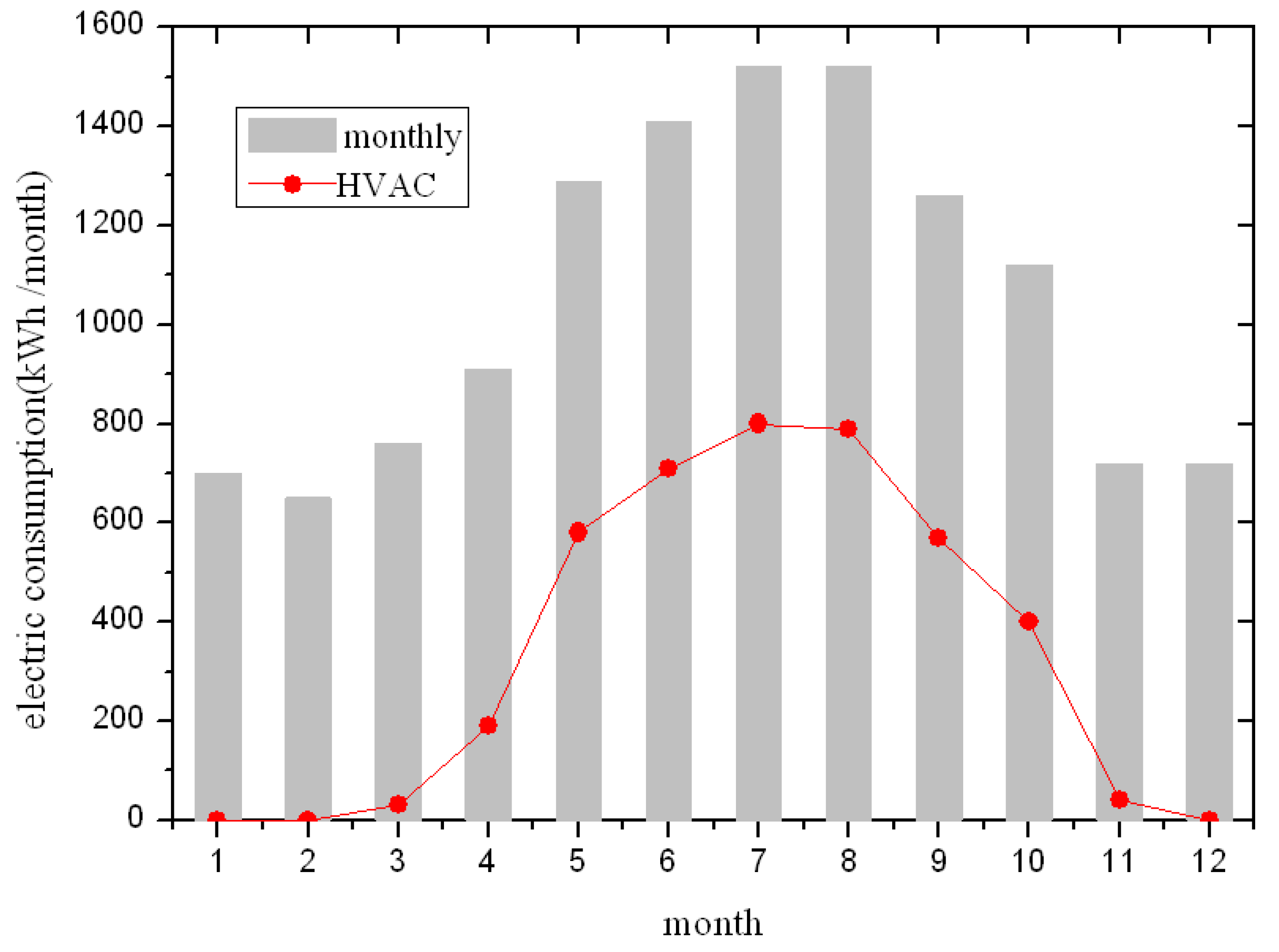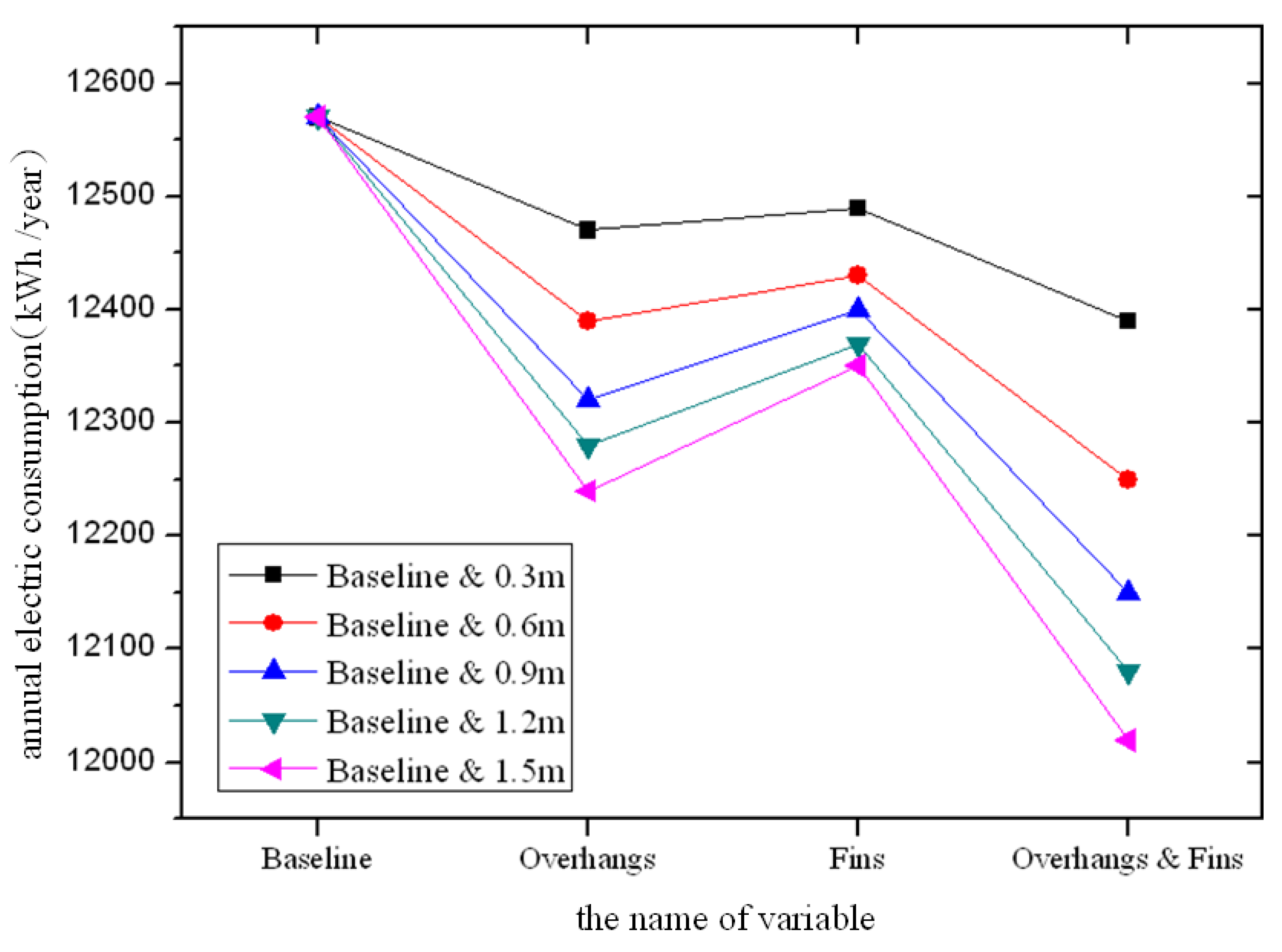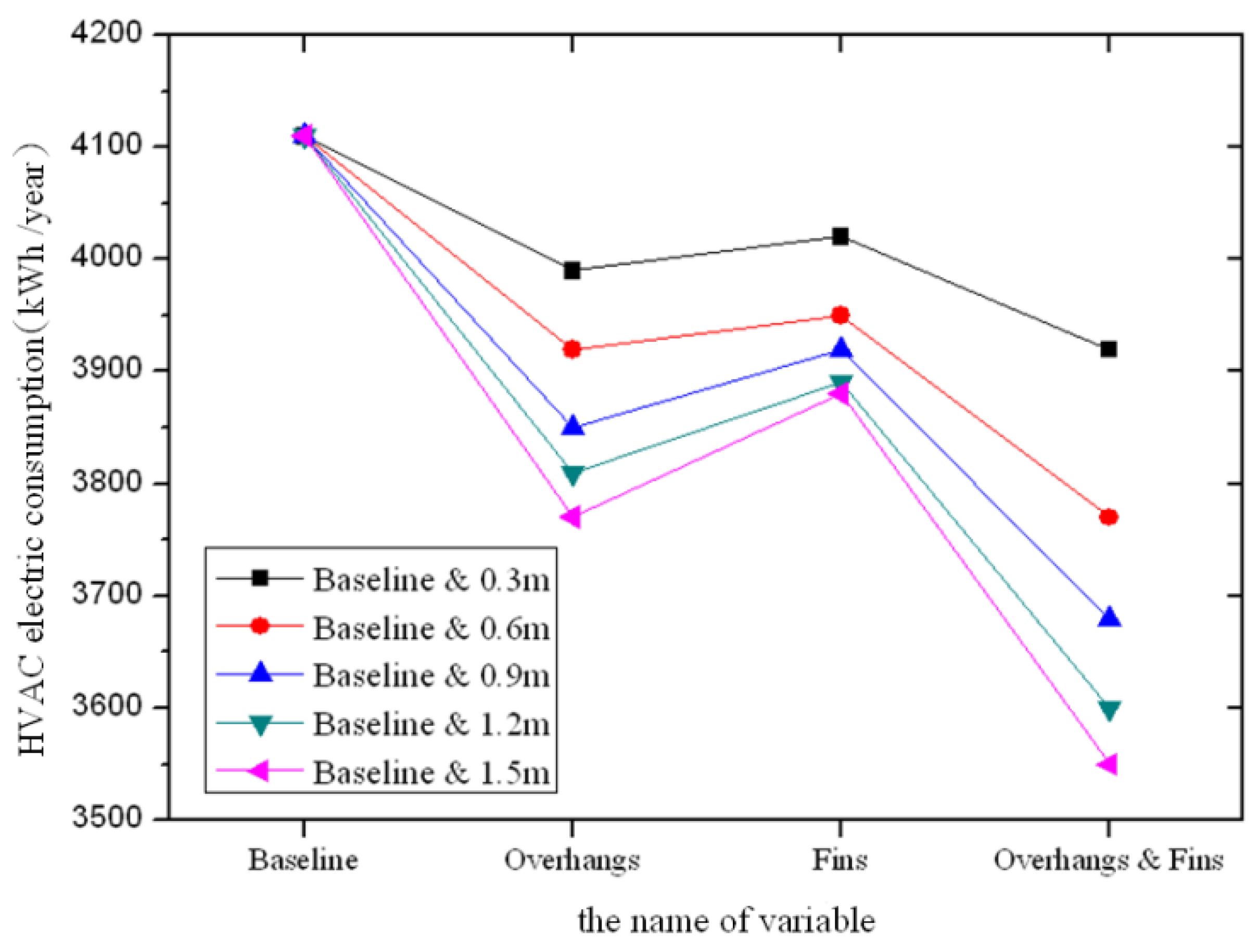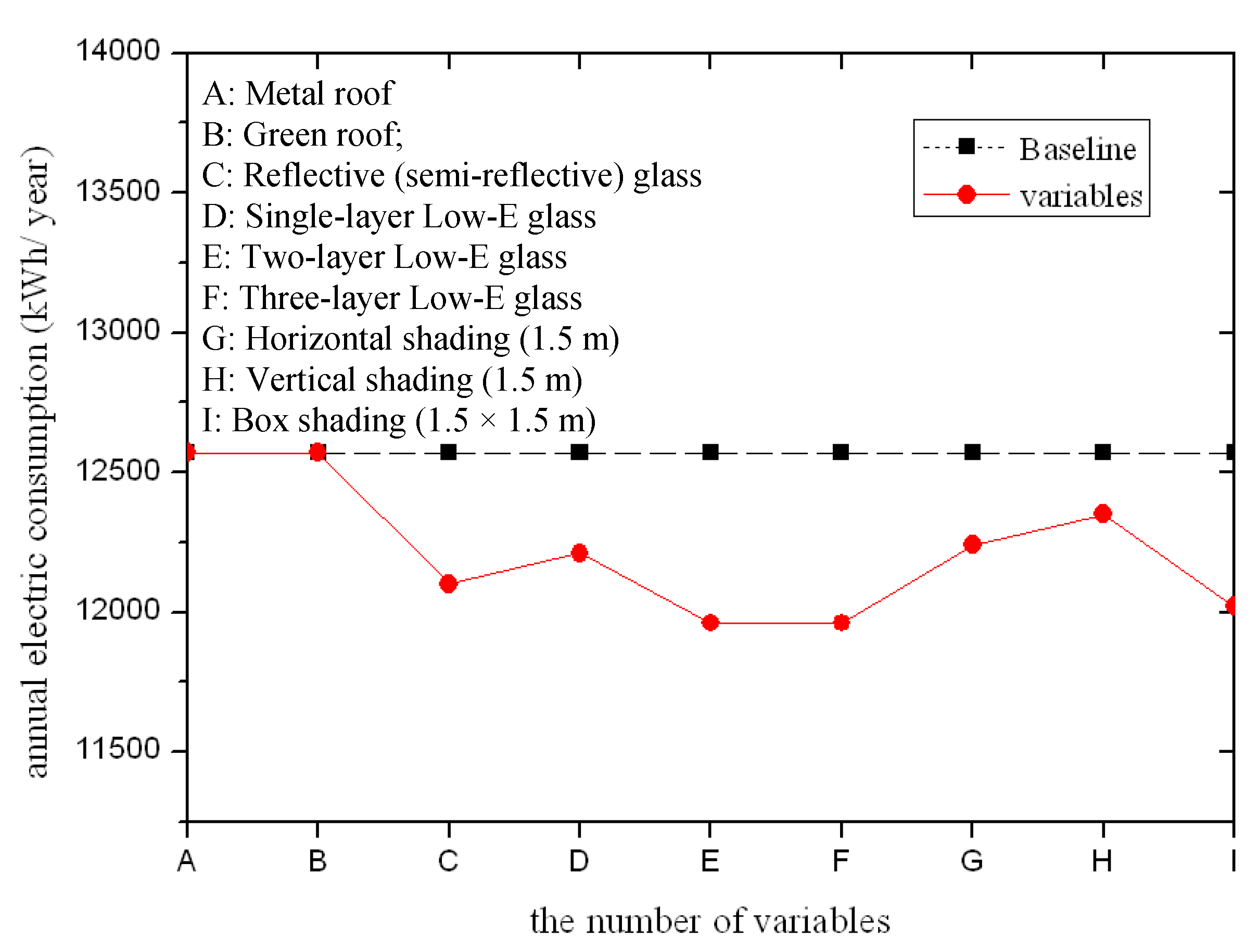1. Introduction
With the continuous increase in the urban population and the air temperature year after year, the proportion of residential houses using air conditioning has also increased, reaching 80% in 2000 [
1]. In addition, up to 50–60% of the energy consumption can be attributed to air conditioners [
2]. In facing this increasing energy consumption of buildings, some studies have proposed energy-saving measures such as renewable energy plans [
3] and effective load management [
4]. A significant goal in achieving greener buildings is learning how to reduce a building’s energy consumption by applying an efficient energy-saving design.
More than 99% of Taiwan’s energy consumption relies on imports, mainly of oil, coal and natural gas. The sum of these three products is almost equal to the total energy supply in Taiwan. This is especially true with the increasing dependence on oil, which in the past two decades has represented more than half of the total energy supply. The main energy-consuming sectors in Taiwan in 2009 were industry (49.7%), services (20.5%), residential buildings (19.5%), energy self-consumed by energy divisions (8.7%), agriculture (1.2%) and transport (0.5%). When the CO2 emission assessment of buildings is carried out on the life cycle span, the amount of CO2 emissions attributable to construction, building material production and transportation for the construction process of reinforced concrete (RC) residential buildings was only 25% of the total amount of CO2 emissions. CO2 emissions from daily usage in buildings occupied greater than 60% of the life cycle span. This shows the importance of reducing CO2 emissions, and therefore, energy consumption, in our daily lives.
In Taiwan, the annual electricity consumption from residential buildings per unit of floor area was 36.29 kWh/(m
2·year). Regardless of whether the buildings were apartment- or house-type buildings, the greatest percentage of electricity usage was from household appliances and occurred in the non-air-conditioning season at approximately 50%, followed by that of lighting equipment, while air conditioning was in last place. During the air-conditioning season, in apartment-type buildings, the percentage of electricity usage from household appliances was 41%, air conditioning was 41% and lighting and other usages was 18%. In house-type buildings, the percentage of electricity consumption from household appliances was 36%, air conditioning was 32%, and lighting and other usages were at 32%. During the air-conditioning season, the average energy consumption increase due to the use of air conditioning was 300 kWh/month [
5]. This trend became increasingly more significant when an investigation was conducted in buildings in the southern regions of Taiwan. This was because the hot weather in the southern area resulted in a greater number of days requiring air conditioning than in northern Taiwan. In an overall comparison, the average power density (kWh/m
2·year) of residential apartments was approximately 1.2 times that of residential houses. The reason for this was that the two building types had little differences in their household appliances. The higher average power density in apartments was due to the relatively smaller area in comparison to houses.
Many factors affect building energy consumption, including the number of people indoors, the amount of electrical appliances used, the air conditioner’s performance, the material of the window glass, shading, the type of building materials used for the roof and walls and the orientation of the building. In general, the most efficient energy-saving approach can start at the exterior of a building, which includes the use of building materials with a lower heat transfer coefficient, a decrease in the percentage of openings and the usage of energy-saving glass. To analyze and manage effectively a building’s energy consumption, many effective analysis tools and simulation software were utilized, such as DOE2, eQUEST, and EnergyPlus.
Among the available analysis tools and simulation software, EnergyPlus and eQUEST were developed based on DOE2. Chirarattananon and Taweekun [
6] used DOE2 to analyze the energy consumption of commercial buildings and government buildings in Thailand. The power consumption of various types of commercial buildings, which include offices, hotels, hospitals, department stores and government buildings, was divided into three different types according to the roof and floor area categories of the buildings. Relative to DOE2, software with friendlier user interfaces has emerged in recent years. Medrano
et al. [
7] installed the DG system in four types of commercial buildings in California and applied eQUEST to conduct a simulation analysis. The variables for analysis included the shading design for windows, lighting control, HVAC efficiency enhancement and cooling capacity enhancement. Results showed that the range of savings for the commercial buildings can reach 5–20%. Yu
et al. [
8] also used eQUEST to design the exteriors of residential buildings in China. The annual energy consumption based on different energy-saving designs was simulated. The best performances were found with better wall insulation and window shading, which respectively saved 11.55 and 11.31% of the energy consumption of air conditioners. Many studies confirmed that the results simulated by this software can be trusted and accepted [
9,
11].
To conduct prerequisite or following works related to building energy analysis, it is feasible to link the eQUEST works with solar irradiation modeling or thermal-flow analysis via computational fluid dynamics (CFD) models. Zervas
et al. [
12] developed a validated prediction model of global solar irradiance distribution on horizontal surfaces, based on neural-network techniques. Stavrakakis
et al. [
13] examined natural cross-ventilation with openings at non-symmetrical locations experimentally in a test chamber and numerically using CFD technique. The computational part of the study consisted of the steady-state application of three Reynolds-Averaged Navier-Stokes (RANS) models to account for the wind and buoyancy effects. Stavrakakis
et al. [
14,
15] illustrated a computational method to optimize window sizes for thermal comfort and indoor air quality in naturally ventilated buildings. A hybrid CFD simulation results were used to predict thermal comfort indices. Mean values of these indices were then calculated for different window sizes to generate a database used to train and validate Radial Basis Function Artificial Neural Network input-output meta-models, which were used to formulate an optimization problem.
In urban and rural areas, whether in the formation of new communities and new buildings or the retrofit of old communities or existing buildings, everyone involved should take energy-saving and carbon-reduction processes into consideration. During Taiwan’s summer season (May to September), the average daily solar heat gain is largest at the windows, followed by the roof surface, and then external walls, with an approximate ratio of 23%, 22.8%, 18.2%. Due to the conventional construction method, people’s perception and economic consideration, the key factors in the energy-saving design of the building exteriors in Taiwan are the thermal performance of the roof and window glazing. This study used the software eQUEST to investigate how different types of roof construction, window glasses and sunshield types affect the energy consumption in residential buildings under common scenarios.
3. Results and Discussion
In consideration of the solar heat gain, the buildings in general would be sited with a north-south direction, but due to the restrictions on the site size, the building regulations and the planning methods, the construction of the residential buildings facing west is unavoidable. In this study, eQUEST software was used to simulate the energy consumption of the buildings within the target city block as described in
Section 2.3, and the results verify that the buildings facing west indeed have greater electricity consumption than the buildings facing other directions. Therefore, this section describes results derived using the buildings facing west (
Figure 1c) as targets for the simulation, in which the various energy consumption factors (as in
Section 2.4) were investigated. Then, a performance comparison with the baseline case was carried out and coordinated with the scenario of Taiwan’s residential buildings. The simulation results for the baseline case are shown in
Figure 6. It can be seen that the months in the summer season were the periods of greater energy consumption. The main source of electricity consumption came from the air conditioners, accounting for nearly 50% or more of the total consumption.
Figure 6.
Monthly energy consumption of the baseline case.
Figure 6.
Monthly energy consumption of the baseline case.
3.1. Roof Construction Effect
Because the building codes in Taiwan required that the minimum U-value for residential roofs be 1.2 W/m2·K, which yields a good insulation performance, the simulation therefore indicates that the changes in the annual energy consumption among different types of roof construction are quite limited. Although the energy efficiency was rather insignificant based on data from the entire year, the green roof still contributed in reducing the electricity consumption and reducing carbon dioxide emissions. To obtain clear results, this study additionally introduced a usage period setting in which the air conditioners were continuously used for 24 h. Because the usage periods by indoor personnel and air conditioners were longer, the green roof effect towards energy efficiency can be seen clearly. In comparison to the RC roof, the green roof can save around 310 kWh of electricity.
3.2. Window Glass Effect
Results showed that the two- or three-layer low-E glass can reduce approximately 610 kWh of the total annual energy consumption. This energy reduction is greater than that of the roof alternative. A comparison of the simulation results of the energy consumption for the various window glasses is shown in
Figure 7. Whether using a reflective glass or the low-E glass, the energy efficiencies were both better than that for the baseline clear glass. The reason for this was the lower U-value and shading coefficient (SC). When comparing between the reflective glass and the single-layer low-E glass, the two samples used in this study showed little difference in the energy efficiency.
Figure 7.
Comparison of annual energy consumption for different window glasses.
Figure 7.
Comparison of annual energy consumption for different window glasses.
However, when other factors apart from energy efficiency were considered, such as indoor lighting, reflective glass had a lower visible light transmittance (VT). The optical property of the reflective glass with a lower VT, on the other hand, allows relatively less visible light to reach the inside. The indoor illumination requirements for residents must also be taken into consideration when designing energy-saving devices. The results of the two- and three-layer low-E glass showed a lower VT when compared to clear glass or single-layer low-E glass, which is the same trend as seen with the reflective glass. As a result, both the energy efficiency and day lighting must be considered at the same time when developing an energy-efficient design.
3.3. Sun Shielding Effect
Compared to the retrofit of the roof construction or window glass, the construction work for exterior shading is more convenient and simple. In addition, it also provides a good energy-efficiency performance. Among these exterior shading devices, horizontal, vertical and box shields are the most common in Taiwan. From the simulation results, it can be seen that the box shields, utilizing a combination of horizontal and vertical exterior shading, had the greatest energy efficiency. When a 1.5 × 1.5 m shading device was compared with the baseline case, the annual electricity savings was approximately 550 kWh. Shading using only horizontal shields could also save 100–330 kWh of electricity, whereas 80–220 kWh of electricity was saved by using just the vertical shading. Overall, the energy efficiency performance of the various types of exterior shading can be compared as: box shading > horizontal shading > vertical shading. For the sizes of the box shields, the vertical and horizontal extension lengths are usually the same due to aesthetic appearance and construction convenience.
However, the box shields would specifically extend only the horizontal or vertical length due to the response of sunshine at specific shielding directions. Therefore, in addition to the box shields using the same vertical and horizontal size, this study also investigated the annual total and air conditioning energy consumptions of box sunshine with different horizontal or vertical lengths. A comparison of the annual total energy and air conditioning energy of the different sunshield types with the baseline case is given in
Figure 8 and
Figure 9. Results show that box shading had the greatest energy efficiency among the three. However, the box shading had a certain influence on indoor lighting. The amount of visible light entering the indoor space was less compared to buildings that use horizontal, vertical or no shading devices. As with the window glass, the energy efficiency and day lighting conditions should both be considered simultaneously.
Figure 8.
Comparison of annual energy consumption between the baseline and various shading variables.
Figure 8.
Comparison of annual energy consumption between the baseline and various shading variables.
Figure 9.
Comparison of HVAC energy consumption between the baseline and various shading variables.
Figure 9.
Comparison of HVAC energy consumption between the baseline and various shading variables.
3.4. Findings
A comparison of the annual electricity consumption among all of the variables is shown in
Figure 10. The size of the sunshields was set to 1.5 m for the comparison. For residential buildings in Taiwan, the results showed that the buildings that used the two-layer low-E glass and the three-layer low-E glass had the greatest energy efficiency, whereas buildings with roofs that underwent retrofit measures had a limited improvement in energy efficiency. Overall, the retrofit measures implemented on the window glass had the largest influence on energy efficiency and sometimes even showed a better performance than the installation of external sunshields. All variables related to the energy efficiency of residential buildings show that the annual energy-efficiency benefit was approximately up to 4.9%, and air conditioning may save up to 15.1%.
Figure 10.
Comparison of annual electricity consumption among different variables.
Figure 10.
Comparison of annual electricity consumption among different variables.
